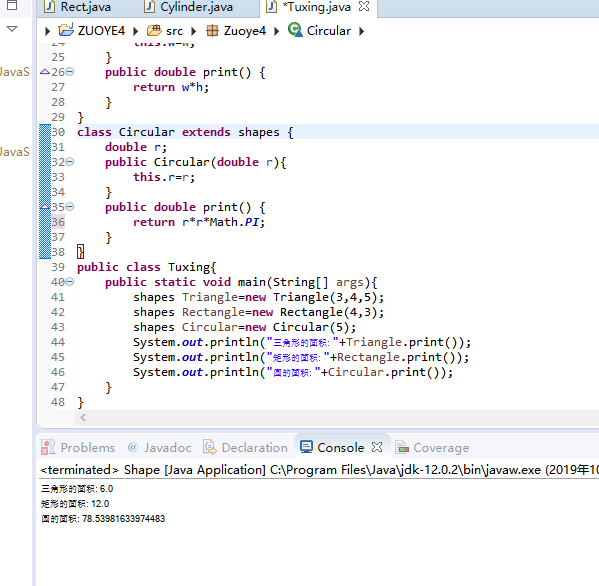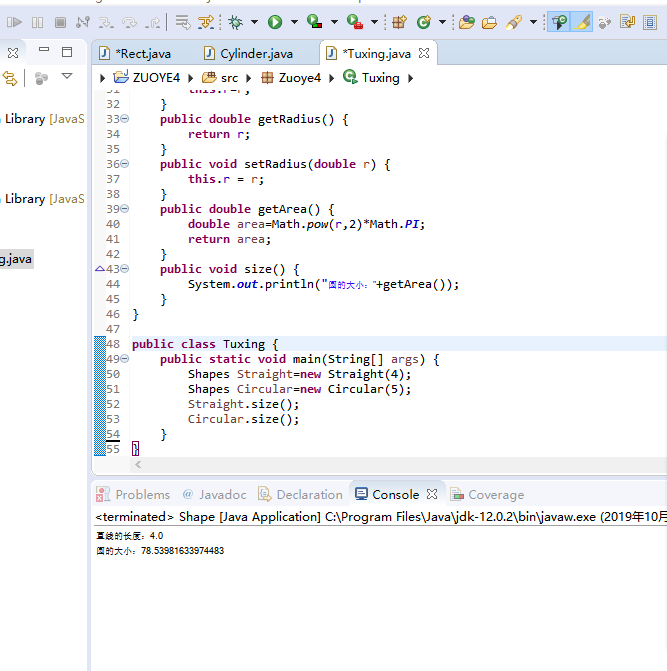实验四 类的继承
实验目的
理解抽象类与接口的使用;
了解包的作用,掌握包的设计方法。
实验要求
掌握使用抽象类的方法。
掌握使用系统接口的技术和创建自定义接口的方法。
了解 Java 系统包的结构。
掌握创建自定义包的方法。
实验内容
(一)抽象类的使用
设计一个类层次,定义一个抽象类--形状,其中包括有求形状的面积的抽象方法。 继承该抽象类定义三角型、矩形、圆。 分别创建一个三角形、矩形、圆存对象,将各类图形的面积输出。
注:三角形面积s=sqrt(p(p-a)(p-b)*(p-c)) 其中,a,b,c为三条边,p=(a+b+c)/2
2.编程技巧
(1) 抽象类定义的方法在具体类要实现;
(2) 使用抽象类的引用变量可引用子类的对象;
(3) 通过父类引用子类对象,通过该引用访问对象方法时实际用的是子类的方法。可将所有对象存入到父类定义的数组中。
package Zuoye4;
abstract class shapes {
public abstract double print();
}
class Triangle extends shapes {
private double a;
private double b;
private double c;
public Triangle(double a,double b,double c){
this.a=a;
this.b=b;
this.c=c;
}
public double print() {
double p=(a+b+c)/2;
return Math.sqrt(p*(p-a)*(p-b)*(p-c));
}
}
class Rectangle extends shapes {
private double w;
private double h;
public Rectangle(double w, double h){
this.h=h;
this.w=w;
}
public double print() {
return w*h;
}
}
class Circular extends shapes {
double r;
public Circular(double r){
this.r=r;
}
public double print() {
return r*r*Math.PI;
}
}
public class Tuxing{
public static void main(String[] args){
shapes Triangle=new Triangle(3,4,5);
shapes Rectangle=new Rectangle(4,3);
shapes Circular=new Circular(5);
System.out.println("三角形的面积: "+Triangle.print());
System.out.println("矩形的面积: "+Rectangle.print());
System.out.println("圆的面积: "+Circular.print());
}
}

(二)使用接口技术
1定义接口Shape,其中包括一个方法size(),设计“直线”、“圆”、类实现Shape接口。分别创建一个“直线”、“圆”对象,将各类图形的大小输出。
编程技巧
(1) 接口中定义的方法在实现接口的具体类中要重写实现;
(2) 利用接口类型的变量可引用实现该接口的类创建的对象。
package Zuoye4;
import java.util.Scanner;
interface Shapes{
public double size();
}
class spot implements Shapes{
private double x1,x2,y1,y2;
public spot(double x1,double x2,double y1,double y2) {
this.x1=x1;
this.x2=x2;
this.y1=y1;
this.y2=y2;
}
public double size() {
return Math.sqrt((x2-x1)*(x2-x1)+(y2-y1)*(y2-y1));
}
}
class Circular implements Shapes{
private double reidus;
public Circular(double reidus) {
this.reidus=reidus;
}
public double size() {
return Math.PI*this.reidus*this.reidus;
}
}
public class Tuxing{
public static void main(String args[]) {
Scanner spot=new Scanner(System.in);
System.out.println("请输入两点的坐标");
double x1=spot.nextDouble();
double y1=spot.nextDouble();
double x2=spot.nextDouble();
double y2=spot.nextDouble();
spot line=new spot(x1,y1,x2,y2);
System.out.println("直线的大小为:"+line.size());
Scanner c=new Scanner(System.in);
System.out.println("请输入圆的半径");
double reidus=c.nextDouble();
Circular circle=new Circular(reidus);
System.out.println("圆的大小为:"+circle.size());
return;
}
}

学习总结
(1)抽象类与接口的应用。
抽象类的实际应用-------模板设计(abstract)
接口的实际应用-------制定标准(interface)
(2)Object类
tostring方法
equals方法
(3)异常
1,数组超出绑定异常:ArrayIndexOutOfBoundsException.
2,数字格式化异常:NumberFormatException.
3,算术异常:ArithmeticException.
try{ //有可能出现异常的语句
}catch(异常类 异常对象){ //编写异常的处理语句
}finally{
一定会运行到的程序代码
}
4.异常类的继承结构
在JAVA中所有捕获范围小的异常必须放在捕获大的异常之前,否则程序在编译时会出现错误提示。
(4)关键字throws
public 返回值类型 方法名称(参数列表.....)throws 异常类{ }

